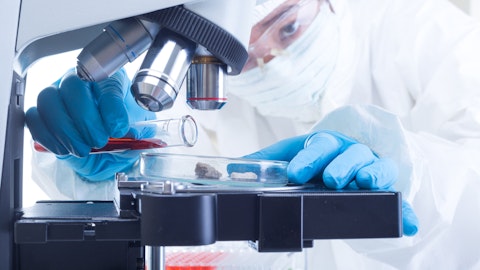MaxCyte, Inc. (NASDAQ:MXCT) Q4 2022 Earnings Call Transcript March 15, 2023
Operator: Good day and thank you for standing by and welcome to MaxCyte’s Fourth Quarter Earnings Conference Call. Please be advised that today’s conference is being recorded. I would now like to hand the conference over to your speaker today, Sean Menarguez of Investor Relations. You may begin.
Sean Menarguez: Thank you, Justin. Good afternoon, everyone. My name is Sean Menarguez and I am the Head of Investor Relations here at MaxCyte. Thank you all for participating in today’s conference call. On the call from MaxCyte, we have Doug Doerfler, President and Chief Executive Officer and Ron Holtz, Interim Chief Financial Officer. Earlier today, MaxCyte released financial results for the fourth quarter and full year ended December 31, 2022. A copy of the press release is available on the company’s website. Before we begin, I need to read the following statement. Statements or comments made during this call maybe forward-looking statements within the meaning of federal securities laws. Any statements contained in this call that relate to expectations or predictions of future events, results or performance are forward-looking statements.
Actual results may differ materially from those expressed or implied in any forward-looking statements due to a variety of factors, which are discussed in detail in our SEC filings. The company undertakes no obligation to publicly update any forward-looking statements, whether because of new information, future events or otherwise. Now with that, I will turn the call over to Doug.
Doug Doerfler: Thank you, Sean and good afternoon and good evening, everyone and thank you for joining MaxCyte’s fourth quarter and full year 2022 earnings call. I will begin with a discussion of our business and operational highlights during the quarter followed by a detailed financial review from Ron. We will then open the call for questions. 2022 was an exciting year for MaxCyte and our team performed excellently in our first full year as a NASDAQ-listed company. Ron will provide more details during the call regarding our financial results, including strong full year revenue, total revenue of $44.3 million representing a year-over-year growth of 31% in 2022. Core business revenue grew 26% in 2022 year-over-year, driven by 33% growth in revenue from cell therapy customers and 8% growth in revenue from drug discovery customers.
For the fourth quarter, core revenues increased 4% compared to the fourth quarter of 2021, with revenue from cell therapy and drug discovery customers growing at 4% to 5% year-over-year. Fourth quarter growth was primarily driven by continued strength in instrument sales and was offset by PA sales below expectations as compared to the prior year. As our partners progress through the clinic and approach commercialization, we are experiencing some lumpiness in PA purchasing patterns. We saw strong growth in PA sales in 2022 over 2021, supporting our confidence in the trajectory of the business overall. We generated $1.9 million of milestone revenue during the fourth quarter and $4.6 million of milestone revenue for the full year in 2022, exceeding our full year milestone revenue guidance of approximately $4 million.
Our partners programs continue to make exciting progress with several entering and/or progressing through the clinic and we continue to see a path toward a first commercially approved partnered product with the exa-cel program, which is currently seeking regulatory marketing approval. Overall, our global customer base is expanding across all stages of development and across a growing variety of diseases. I do want to point out that the cell therapy sector is experiencing delays in clinical programs. However, this is to be expected in the development of new therapeutic modalities endeavoring to alleviate the burden of disease for many patients that have little or no alternatives. We believe 2023 maybe a challenging year for the industry as companies rationalize their internal pipeline due to funding constraints, but we continue to see developers focusing on and investing in their lead assets program and development.
As discussed last year, we are typically working with our partners lead and/or second clinical program asset, which positions us well. Additionally, we are continuing to see new company formation and financing in more complex engineered cells across a variety of novel cell types, which positions us well to enable the next generation of engineered cell therapies. Furthermore, we see heightened focus on clinical data regarding novel approaches, especially in comparison to crowded disease areas and crowded targets. This will result in more rationalization as developers work to bring novel therapeutic modalities in and through the clinic. MaxCyte is well positioned supporting numerous clinical programs across a variety of disease areas, target cell types and therapeutic modalities.
Rationalization of clinical assets is also good as the sector focuses investment on the most promising clinical programs and advanced therapeutic modalities forward to patients with unmet medical needs. We are particularly encouraged by our traction with early development stage of cell therapy customers, including leading academic clinical translation centers. We now have greater than 600 instruments sold or leased with the customers around the globe as compared to just over 500 instruments at the end of 2021. Additionally, our partnership pipeline remains robust as we begin 2023. Both current partners and potential partners are conducting development work at the late-stage preclinical and clinical stage across the wide array of cell types, approaches and new indications.
The prospects for our existing partners are greater today than they were a year ago and our pipeline of new partners continues to expand not only in number, but across the breadth of therapeutic modalities and indications, including rare diseases, autoimmune neurodegenerative disease and solid tumors. Note that due to confidentiality of our partnership agreements, we are not able to answer any specific questions related to individual partners, their clinical progress or their respective development programs. In 2022, we signed three partnerships and have added one thus far in 2023. We also established a partnership with Vertex following the transfer of the exa-cel program from CRISPR which is currently seeking regulatory marketing approval in the United States and Europe for sickle cell disease and beta-thalassemia.
In addition, we retained our partnership with CRISPR Therapeutics supporting CRISPR/CAS9-based therapies in immunooncology. The total number of partnerships as of today stands at 19 and we expect to add partnerships at our historic rate in 2023. As of December 31, 2022, our 18 partnerships allowed for more than 125 programs think of drugs, of which 16 were active programs in the clinic. This compares to 15 partnerships covering 95 programs, of which 15 were active in the clinic as of year end 2022. The total pre-commercial partnership revenue potential for our SPL programs is now greater than $1.55 billion, up from $1.25 billion at the end of 2021, an increase of over $300 million in potential pre-commercial milestones payments. At the end of the fourth quarter, we signed a partnership with Curamys, a South Korean biotech company that develops cell and gene therapy using their proprietary cell fusion technology to treat rare intractable diseases, including the Duchenne muscular dystrophy and ALS.
This is our second partnership signed in the Asia-Pacific region and we are encouraged by the geographic expansion of our partnership profile. Additionally, early this year in 2023, we signed a partnership with Catamaran Bio, a Boston-based biotechnology company developing novel off-the-shelf CAR NK cell therapies to treat a variety of solid tumors, including renal cell carcinoma, breast cancer and gastric cancer. We are also encouraged to see the FDA recognizing recent progress in our most important end market, cell therapy following 5 cell and gene therapy approvals in 2022 compared to an average of less than 2 per year in the prior 5 years and 100 new FDA positions funded in the 2022 PDUFA legislation to focus on cell and gene therapy beginning in 2023.
If approved, exa-cel will be the first non-viral engineered cell therapy product commercialized and we believe it will establish non-viral engineered cells as a new therapeutic modality solidifying MaxCyte’s position as the premier enabler of non-viral cell therapies from concept to patients. In 2022, we made important investments across multiple areas to support growing global end markets and in preparation for our partners’ progression through the clinic toward commercial launch. These included investments in our internal and field science, regulatory, quality assurance, applications, process development, engineering and supply teams as well as expansion of our sales, alliance support and marketing teams. We intend to continue to invest in people and capabilities to support the progress of our customers and the capabilities of our commercial organization.
We also expanded our in-house manufacturing capabilities with the opening of our new headquarters in Rockville, Maryland in 2022. Our expanded manufacturing capacity positions us to support current and future partners as our partner programs grow and scale into later stage programs and potential commercialization. We launched our ExPERT VLx Large Scale Transfection System during September of 2022 and are currently focused on early access customers, many of whom are existing users of our current smaller scale platforms, including the STX. The launch of the VLx instrument expands the MaxCyte ExPERT platform to a broader range of applications, a large-scale bioprocessing offering greater scale for development and manufacturing. This use case spans across several applications such as transient protein production and is focused on preclinical development in early-stage clinical trials.
The key capabilities of the VLx instrument enable customers to shorten development timelines, have broad capability and workflow integration and flexibility. In 2023, we are continuing to make investments to support MaxCyte’s future success and financial growth as well as customers and partner success. These investments include growing our commercial teams, expanding our manufacturing capability, including automation, enhancing our process development capabilities and investing in ongoing internal product development. In addition, we continue to make investments in our applications team to enable the rapidly growing market of next-generation cell therapies. We believe our targeted investments in 2022 and business momentum across our customer base positions us well for continued success in 2023 and over the long-term.
We finished the year well funded and continue to have a strong balance sheet of $227 million to support our expected growth. Finally, we’re pleased to announce the appointment of Patrick Balthrop through our Board of Directors in December, Patrick’s deep experience in life sciences will be an invaluable asset for the MaxCyte team as we continue to advance the next generation of cell therapy discovery, development and commercialization. In summary, we are very pleased with our full year 2022 results, and we believe we began 2023 well positioned to execute on our financial and strategic objectives over the long-term. I’d like to close by thanking the dedicated team at MaxCyte for their commitment and hard work, which enables our success in driving the next generation of cell-based therapies.
I will now turn the call over to Ron to discuss our financial results. Ron?

Copyright: nexusplexus / 123RF Stock Photo
Ron Holtz: Thank you, Doug. I want to start by addressing a question that I expect may be top of mind due to recent events. MaxCyte did have a small foreign currency transactions account at Silicon Valley Bank. That account held an immaterial amount of capital and the events of the past few days represent no material risk to the company or its assets. Turning to our financial results. Full year total revenue was $44.3 million, representing growth of 31% over 2021. Total revenue in the fourth quarter of 2022 was $12.4 million compared to $10.2 million in the fourth quarter of 2021 or 22% growth. In the fourth quarter, we reported core revenue of $10.6 million compared to $10.1 million in the fourth quarter of 2021 or 4% growth, this includes revenue from cell therapy customers of $7.5 million, growing 4% year-over-year and revenue from drug discovery of $3 million, up 5% year-over-year.
Core revenue growth for the fourth quarter was driven by continued strength in instrument sales, although somewhat offset by timing of PA sales as compared to the prior year quarter. As Doug explained, we saw some lumpiness in PCLs late in the year. However, overall, in 2022, PA sales was a key revenue growth driver that supports our confidence in the trajectory of the business overall. For the full year 2022, we reported core revenue of $39.6 million compared to $31.4 million in 2021 or 26% growth. This includes revenue from cell therapy customers growing 33% year-over-year and drug discovery revenue growing 8%. We recognized $1.9 million of SPL program-related revenue on strong partner clinical progress in the fourth quarter of 2022 as compared to immaterial milestone revenue in the fourth quarter of 2021.
For the full year, we recognized $4.6 million in milestone revenues as compared to $2.5 million last in the prior year, exceeding our forecasted milestone guidance of approximately $4 million. Moving down the P&L, gross margin was 88% in both the fourth quarter of 2022 and 2021. Total operating expenses for the fourth quarter of 2022 were $17.6 million, compared to $13.9 million in the fourth quarter of 2021. The increased operating expenses was in line with our long-term growth strategy as we invested in the staffing of our field sales, field application scientists engineering and manufacturing and lab teams. We believe the investments made in 2022 position us well to support our customers and partners as they progress into and through clinics and into commercial stages.
Heading into 2023, we have a healthy balance sheet with combined cash, cash equivalents and short-term investments of $227 million as of December 31, 2022, and of course, no debt. Moving on to our outlook for 2023. We expect full year total revenue growth of between 21% and 26% over 2022, including core business growth of between 20% and 25% and SPL program-related revenue of approximately $6 million. As Doug discussed, we believe we are well positioned for continued strong growth in 2023, and our guidance incorporates some conservatism for the broader macroeconomic environment and other factors, which make 2023 somewhat more challenging to forecast than past years. As we have discussed previously, the timing of partnership revenue is predicated in our customers’ clinical and regulatory progress and therefore, it’s fundamentally more difficult to predict in core revenues.
As noted, our initial expectations for milestone revenue in 23, is approximately $6 million. And I want to point out that, that is a risk-adjusted forecast that’s achievable under a variety of potential outcomes across our 19 announced partnerships and their planned clinical progress. I’d like to add a brief comment on the expected seasonality for 2023. Recall that in 2022, that year was a bit of an anomaly with near 50-50 split of first half versus second half revenue driven by the dynamics of purchase patterns as partners approach later stage development and commercialization. In 2023, we expect to return to more normal historical seasonality with roughly a 40%, 60% first half, second half revenue split, revenues from TA’s, instruments and milestones grow strongly as later-stage partners approach and enter commercialization, but it can be lumpy, impacting quarterly outcomes and annual seasonality as we’ve seen in those and we’re seeing those effects in 2022 and 2023.
And in that context, it’s important to highlight the magnitude of what one later stage partner can deliver as we see the first of 19 partners approaching commercialization. And worth noting that we are very confident that our total SBL partnerships will grow continue to grow through 2023. Finally, I want to note our strong financial position as we expect to end this year with approximately $200 million of cash, cash equivalents and short-term investments and no debt. Overall, we are pleased with our full year 2022 performance. We’re confident in our 2023 outlook, and we believe that our modest cash burn and debt-free balance sheet will support our future plans for profitable growth. Now I’ll turn it back to you, Doug.
Doug Doerfler: Thanks Rob. So in summary, we are encouraged by our full year achievements and remain optimistic about our growth opportunities in 2023 and beyond. We’re excited about the opportunity to lead the industry forward as the premier cell engineering platform technology supporting the development of advanced cell-based therapeutics for patients who may otherwise have treatment options. We are fully aware of the challenges in our industry and are working hard to support and enable the industry’s success. As always, we think our MaxCyte team as well as our Board, suppliers, investors, partners and the amazing industry that we have the honor of serving to enable the development and commercialization of therapies for patients and their families. With that, I will turn the call back over to the operator for our Q&A. Operator?
See also 11 Undervalued Dividend Aristocrats to Buy and 15 Largest Orthopedic Companies in the World.
Q&A Session
Follow Maxcyte Inc.
Follow Maxcyte Inc.
Operator: And our first question comes from Julie Simmonds from Panmure Gordon. Your line is now open.
Julie Simmonds: Thank you. And congratulations on a good set of results, guys. In terms of just one question, I suppose the sort of one particularly on my mind at this point is obviously looking for potentially your first commercial product potentially by the end of this year. Does that mean that this year has more sort of regulatory risk to it from your perspective, having moved into the new site and are you comfortable that you are up to speed with what is required there because I’m assuming that’s part of your process as part of the process as a whole?
Doug Doerfler: Well, thanks for the question, Julie. And we are, I mean, this is something that we’ve been hopeful and now anticipating for the last several years. It’s one of the reasons why we’ve been making the investments in quality systems. Our new regulatory Vice President is on board. And we work very closely with all of our partners to ensure that we’re in line with their expectations and the agency’s expectations in terms of how we operate and control our manufacturing and supply chains to our customers. So we’re very confident that we’re going to be able to continue to support them through this final at least one product’s final regulatory path and into commercialization. So we’re very comfortable with our investments and our position.
Julie Simmonds: Thank you.
Operator: And thank you. And our next question comes from Dan Arias from Stifel. Your line is now open.
Dan Arias: Good afternoon, guys. Thanks for the questions. Doug, I appreciate the comment on the outlook. It seems like you feel pretty good about the business, but I am sensing some increased cautiousness just on the dynamics that you’re seeing in the market. Can you just talk a bit about the view out the window and the extent to which some of the things that you mentioned are related to your customers specifically or more just across the industry or the landscape? Thanks.
Doug Doerfler: Dan, this is a general thought. I mean it’s obviously, we had a bit of a hiccup more than a hiccup last week. I think that’s going to I think it’s going to encourage everyone to take a harder look at expenses next year. Focus on the assets that are bringing value to the company, our partners. As we’ve said many times, that we typically are working with their lead or second asset. So I think in large part, that’s going to not have a negative impact on us. But we also know that there is some rationalization going on. We’ve called that with some of the sickle cell programs in the last couple of weeks. I think you’re going to also my view is we are going to probably start seeing that with some of the other allogeneic programs.
As some of these lead assets that we are developing and others are developing, our partners are developing start to show some pretty remarkable clinical data. And my sense our sense is that, that rationalization is going to happen. You’re going to end up having some culling of programs. So my sense, again, personally, I think that’s part of what we’re involved with, with this early stage let’s not forget, we’re still involved with a number of very early stage therapeutic development assets, and there is going to have to be some rationalization. So it’s more of an overall view. We’re being cautious, but I also think that we have been able to build in with our investment recently, our ability to cover more of the global market and to be a more effective partner and a more effective supplier.
Dan Arias: Okay, thanks very much.




